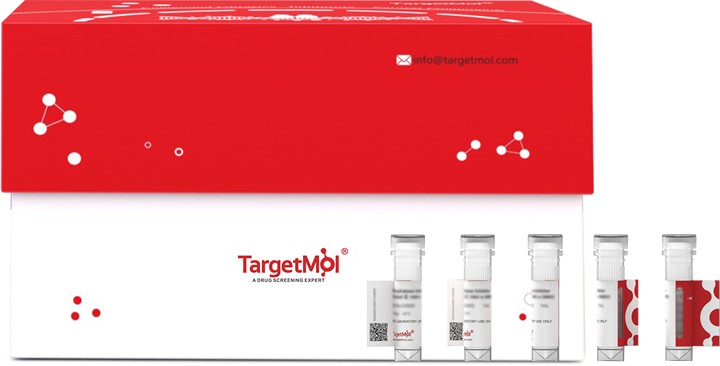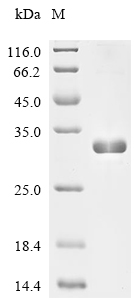 Your shopping cart is currently empty
Your shopping cart is currently empty
Metalloprotease stcE Protein, E. coli O157:H7, Recombinant (His)
Virulence factor that contributes to intimate adherence of enterohemorrhagic E.coli (EHEC) O157:H7 to host cells. Is able to cleave the secreted human mucin 7 (MUC7) and the glycoprotein 340 (DMBT1/GP340). Also cleaves human C1 inhibitor (SERPING1), a regulator of multiple inflammatory pathways, and binds and localizes it to bacterial and host cell surfaces, protecting them from complement-mediated lysis. Therefore, the current model proposes two roles for StcE during infection: it acts first as a mucinase, allowing passage of EHEC through the oral cavity by cleaving the salivary glycoproteins that are responsible for bacterial aggregation. Similarly, in the colon, StcE cleaves the glycoproteins that protect the intestinal epithelial surface, allowing EHEC to come into close contact with host cell membranes. Secondly, it acts as an anti-inflammatory agent by localizing SERPING1 to cell membranes.

Metalloprotease stcE Protein, E. coli O157:H7, Recombinant (His)
| Pack Size | Price | USA Warehouse | Global Warehouse | Quantity |
|---|---|---|---|---|
| 5 μg | $129 | - | In Stock | |
| 10 μg | $216 | - | In Stock | |
| 20 μg | $360 | - | In Stock | |
| 50 μg | $543 | 20 days | 20 days | |
| 100 μg | $745 | 20 days | 20 days | |
| 200 μg | $1,070 | 20 days | 20 days | |
| 500 μg | $1,730 | 20 days | 20 days | |
| 1 mg | $2,530 | 20 days | 20 days |
Product Information
| Biological Activity | Activity has not been tested. It is theoretically active, but we cannot guarantee it. If you require protein activity, we recommend choosing the eukaryotic expression version first. |
| Description | Virulence factor that contributes to intimate adherence of enterohemorrhagic E.coli (EHEC) O157:H7 to host cells. Is able to cleave the secreted human mucin 7 (MUC7) and the glycoprotein 340 (DMBT1/GP340). Also cleaves human C1 inhibitor (SERPING1), a regulator of multiple inflammatory pathways, and binds and localizes it to bacterial and host cell surfaces, protecting them from complement-mediated lysis. Therefore, the current model proposes two roles for StcE during infection: it acts first as a mucinase, allowing passage of EHEC through the oral cavity by cleaving the salivary glycoproteins that are responsible for bacterial aggregation. Similarly, in the colon, StcE cleaves the glycoproteins that protect the intestinal epithelial surface, allowing EHEC to come into close contact with host cell membranes. Secondly, it acts as an anti-inflammatory agent by localizing SERPING1 to cell membranes. |
| Species | E. coli |
| Expression System | E. coli |
| Tag | N-6xHis |
| Accession Number | O82882 |
| Synonyms | tagA,stcE,Secreted protease of C1 esterase inhibitor from EHEC,Neutral zinc metalloprotease StcE,Mucinase,Metalloprotease StcE |
| Amino Acid | ELLLHTIDIGMLTTPRDRFDFAKDKEAHREYFQTIPVSRMIVNNYAPLHLKEVMLPTGELLTDMDPGNGGWHSGTMRQRIGKELVSHGIDNANYGLNSTAGLGENSHPYVVAQLAAHNSRGNYANGIQVHGGSGGGGIVTLDSTLGNEFSHEVGHNYGLGHYVDGFKGSVHRSAENNNSTWGWDGDKKRFIPNFYPSQTNEKSCLNNQCQEPFDGHKFGFDAMAGGSPFSAANRFTMYTPNSSAIIQRFFENKAVF |
| Construction | 296-551 aa |
| Protein Purity | > 85% as determined by SDS-PAGE.  |
| Molecular Weight | 32.3 kDa (predicted) |
| Endotoxin | < 1.0 EU/μg of the protein as determined by the LAL method. |
| Formulation | If the delivery form is liquid, the default storage buffer is Tris/PBS-based buffer, 5%-50% glycerol. If the delivery form is lyophilized powder, the buffer before lyophilization is Tris/PBS-based buffer, 6% Trehalose, pH 8.0. |
| Reconstitution | Reconstitute the lyophilized protein in sterile deionized water. The product concentration should not be less than 100 μg/mL. Before opening, centrifuge the tube to collect powder at the bottom. After adding the reconstitution buffer, avoid vortexing or pipetting for mixing. |
| Stability & Storage | Lyophilized powders can be stably stored for over 12 months, while liquid products can be stored for 6-12 months at -80°C. For reconstituted protein solutions, the solution can be stored at -20°C to -80°C for at least 3 months. Please avoid multiple freeze-thaw cycles and store products in aliquots. |
| Shipping | In general, Lyophilized powders are shipping with blue ice. Solutions are shipping with dry ice. |
| Research Background | Virulence factor that contributes to intimate adherence of enterohemorrhagic E.coli (EHEC) O157:H7 to host cells. Is able to cleave the secreted human mucin 7 (MUC7) and the glycoprotein 340 (DMBT1/GP340). Also cleaves human C1 inhibitor (SERPING1), a regulator of multiple inflammatory pathways, and binds and localizes it to bacterial and host cell surfaces, protecting them from complement-mediated lysis. Therefore, the current model proposes two roles for StcE during infection: it acts first as a mucinase, allowing passage of EHEC through the oral cavity by cleaving the salivary glycoproteins that are responsible for bacterial aggregation. Similarly, in the colon, StcE cleaves the glycoproteins that protect the intestinal epithelial surface, allowing EHEC to come into close contact with host cell membranes. Secondly, it acts as an anti-inflammatory agent by localizing SERPING1 to cell membranes. |
Dose Conversion
Calculator
Tech Support
| Size | Quantity | Unit Price | Amount | Operation |
|---|

Copyright © 2015-2026 TargetMol Chemicals Inc. All Rights Reserved.



